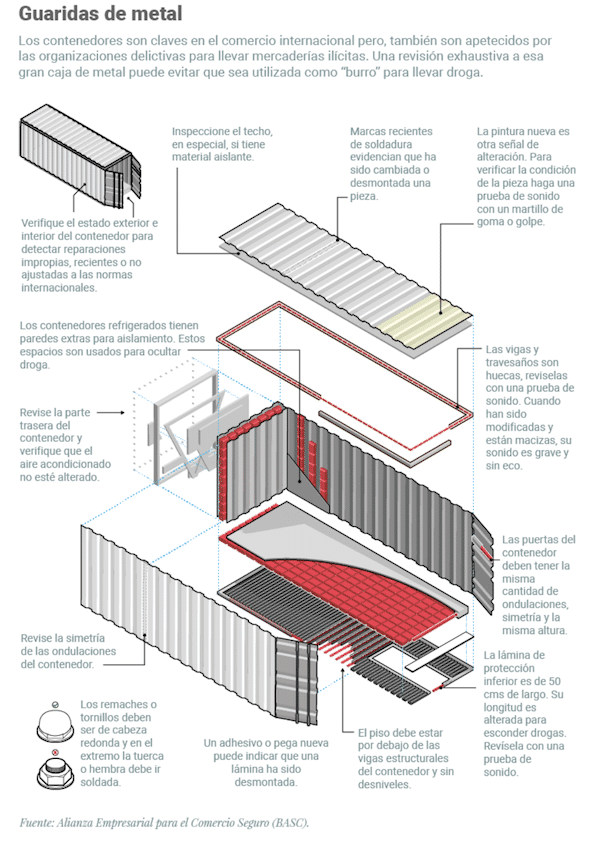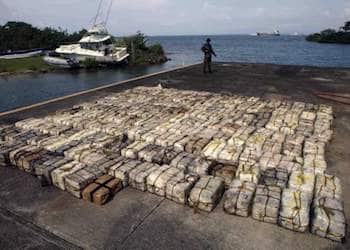A recent report has shed new light on the dynamics of the drug trade in Costa Rica, highlighting how transnational criminal groups have co-opted local individuals and industries to further their criminal enterprises.
An extensive investigation by local news outlet La Nación shows the important and growing role Costa Rica plays in the transit of South American cocaine heading to the United States, Europe and other markets.
The report reveals how criminal networks involving Costa Ricans, Mexicans, Colombians and others have taken advantage of the country’s strategic location and local conditions in order to traffic large amounts of drugs to major consumer markets.
It also explores the negative effects that this burgeoning illicit business has had in Costa Rica, traditionally one of Central America’s most secure and stable countries.
Internal Logistics
Multinational criminal groups, primarily Mexican and Colombian ones, have been known to have a presence in Costa Rica in the past. But the La Nación investigation underscores the importance of local support for the smooth operation of transnational criminal schemes.
According to the report, foreign drug trafficking groups often subcontract Costa Ricans to help with local logistics. Costa Ricans will pick up cocaine shipments at strategic points throughout the country, particularly along the Pacific and Caribbean coasts, then store and transport them domestically for re-shipment.
SEE ALSO: Special Investigation: Costa Rica in the Crosshairs
Costa Rica Security Minister Gustavo Mata told La Nación that overwhelmed authorities are unable to detect most of the cocaine passing through the country.
“This is a tsunami. They take advantage of air space, land borders, maritime [routes],” he said. “It’s a constant bombardment. While the police find one shipment, three or four more are entering.”
With an influx of cocaine passing through Costa Rica, domestic consumption of the drug has grown, perhaps as a result of an increased amount of the product staying in the country.
According to Costa Rica’s Institute on Alcoholism and Drug Addiction (Instituto sobre Alcoholismo y Farmacodependencia), the percentage of citizens reporting “recent” use of cocaine has shot up almost sixfold in the past decade, from 0.2 percent in 2006 to 1.1 percent in 2016.
Export Experts
In addition to long stretches of both Atlantic and Pacific coastline, Costa Rica has proven advantageous for drug traffickers due to its agriculture and legitimate shipping industries.
La Nación reports that traffickers have made particular use of the country’s main Caribbean port of Limón, where conflict over the drug trade has been linked to growing violence. Drug loads are often hidden in shipments of agricultural exports.
For example, in July 2011, Spanish authorities seized 37 kilograms of cocaine stashed in a shipment of pineapples. A subsequent investigation uncovered that that the network responsible was headed by a Colombian who worked with a Costa Rican in charge of buying and dispatching the cocaine, while a Mexican recruited men from a local hardware store to help with the work.
The evidence also suggested a high degree of sophistication on the part of the crime group. The shipping containers were reportedly modified by professional welders in order to create a hiding place to conceal the cocaine.

(Credit: La Nación)
La Nación points out that the use of agricultural exports to hide illicit goods can have a negative impact on local businesses — for example, if their products are seized or spoiled.
Some companies have reportedly begun hiring security personnel and making use of cameras, scanners, drug dogs and other methods to detect alterations to shipments. But the cost of these measures can be prohibitive for smaller shipping firms, making them more vulnerable to drug traffickers.
Ants and Mules
In addition to taking advantage of Costa Rica’s export industry to send large consignments of drugs, traffickers have also operated smaller-scale schemes in the country.
One example is the “ant” method of trafficking drugs, which involves dispatching numerous “mules” with small shipments of drugs that can add up to a large total, lessening the risk of massive losses when individual shipments are seized. Indeed, between 2012 and June 2016, authorities seized 1.5 metric tons of cocaine from would-be drug mules and passengers on commercial airline flights.
SEE ALSO: Coverage of Costa Rica
La Nación links the success of this method in Costa Rica to lax airport security. The news outlet reports that 137 drug mules successfully passed through Costa Rican airport security between 2010 and 2016 before being intercepted abroad.
Costa Rica’s mail system is also vulnerable to being used for drug trafficking. According to La Nación, criminal groups have infiltrated the country’s postal services to ensure that drug packages can evade security checks.
‘No Chocolate Without Cacao’
Authorities in Costa Rica have proposed some measures to combat organized crime in the country, such as increasing law enforcement cooperation with neighboring nations. But these measures may have only a limited impact.
Costa Rica’s own security forces have been stretched thin by the boom in the cocaine trade, which is simultaneously fueling crime groups that officials are blaming for rising murder rates. And the country has put forth some questionable responses, including drastically shortening the training time for police officers.
Although the United States offered a $30 million security aid package to Costa Rica last year, resource constraints are likely to be major obstacle. As La Nación reported last year, a lack of funds has hampered the country’s ability to follow through on some of its anti-crime proposals.
As one politician quipped at the time, “You can’t make chocolate without cacao.”

